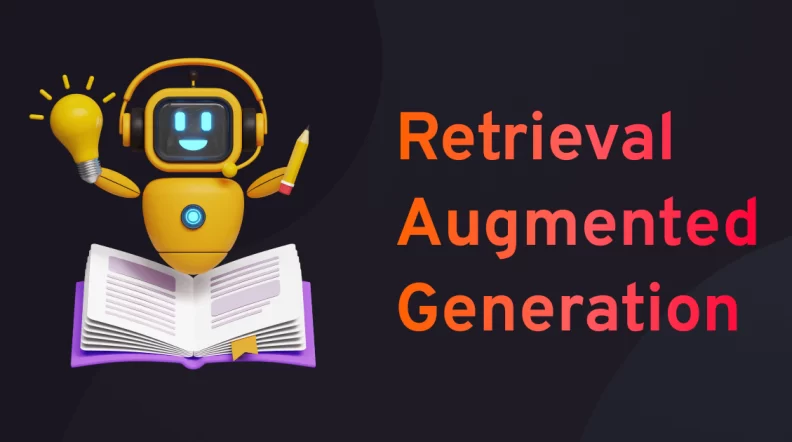The Comprehensive Guide to Retrieval-Augmented Generation






Retrieval-Augmented Generation (RAG) represents a transformative approach in the field of artificial intelligence, blending the efficiency of generative AI models with the vast knowledge contained in external sources. This synergy enables the creation of more nuanced and contextually aware AI applications. By leveraging the information outside the initial training data, RAG significantly enhances the capabilities of generative AI models, making them more adaptable and intelligent.
The concept of RAG is not just a theoretical advancement but a practical tool that has begun to reshape how machines understand and generate human-like text. This guide aims to demystify the intricacies of RAG, providing insights into its mechanisms, applications, and the future it heralds for generative AI. As we delve into the foundations and explore the potential of RAG, it becomes evident how this technology is set to redefine the boundaries of what AI can achieve.
Understanding the Basics of Retrieval-Augmented Generation
At its core, Retrieval-Augmented Generation combines generative AI models with the breadth of knowledge from external sources. This process enriches the AI’s output, offering more accurate and contextually relevant responses.
Evolution and Definition
The journey of Retrieval-Augmented Generation began as an effort to overcome the limitations of standalone generative AI models by integrating external knowledge.
The Birth of RAG
The inception of RAG was marked by the integration of vector databases into the framework of generative AI. Vector databases, which store data in a format that AI can rapidly search through, became the bridge between voluminous external information and the generative models. This innovation allowed for the dynamic retrieval of information at the time of generation, vastly expanding the capabilities of AI systems.
How RAG Powers Generative AI
RAG revolutionizes generative AI by facilitating access to a wider range of data sources.
Enhancing Contextual Understanding
The integration of diverse data sources into generative AI workflows significantly broadens the AI’s understanding of context. This enriched contextual awareness allows AI models to produce responses that are not only relevant but also deeply nuanced, reflecting a better grasp of the subject matter.
The Mechanisms Behind Retrieval-Augmented Generation
The magic of RAG lies in its ability to seamlessly merge the creative prowess of generative AI models with the depth of knowledge stored across various platforms. This synergy enables the generation of content that is both original and informed, pushing the boundaries of what AI can achieve.
The Process: From Retrieval to Generation
RAG excels in handling knowledge-intensive tasks by drawing on external knowledge sources. This process begins with understanding customer queries, retrieving relevant source documents, and finally, using a generator model to craft responses that are both accurate and informative.
Creating and Updating External Data
The success of RAG relies heavily on the quality of data sources and the generative AI models’ ability to interpret them. By converting the information from these sources into numerical representations, AI models can better understand and utilize the data. This continuous cycle of creating and updating the data set ensures that the original training data remains dynamic and evolves over time, keeping the generative AI models at the forefront of innovation.
Distinguishing Between RAG and Semantic Search
Retrieval-Augmented Generation (RAG) and Semantic Search may seem similar at first glance, but they serve different purposes in the realm of AI. RAG combines the power of pre-trained models with the ability to retrieve data from external sources, thus enriching the generative process. This approach allows for more accurate and contextually relevant outputs. On the other hand, Semantic Search focuses on understanding and interpreting the intent behind queries to fetch the most relevant responses from vector databases. While RAG is about generating new content by leveraging external knowledge, Semantic Search aims at finding the existing information that best matches the query’s intent.
The Importance of Vector Databases in RAG
Vector databases play a crucial role in Retrieval-Augmented Generation by enabling the efficient storage and retrieval of information. These databases are designed to handle the complexities of high-dimensional data, making them indispensable for RAG. By converting text into vectors, these databases allow RAG systems to quickly find and utilize relevant information from massive external knowledge bases. This capability is essential for enhancing the quality and relevance of the generated content, highlighting the importance of vector databases in the RAG framework.
Vector Databases: The Backbone of Semantic Search
Vector databases represent the core of Semantic Search, allowing for nuanced and context-aware results.
How RAG Utilizes Vector Databases
In the RAG framework, vector databases are not just storage solutions but pivotal in bridging the gap between vast amounts of data and the generation of relevant content. By indexing information as vectors, these databases empower RAG systems to efficiently retrieve data that is contextually relevant to the input query. This retrieval capability, rooted in vector databases, enables RAG to produce outputs that are not only accurate but also rich in detail and relevance, showcasing the critical role these databases play in the RAG process.
Advancements and Applications
RAG is steering remarkable advancements and applications across various sectors.
Real-World Uses of RAG
RAG technology is transforming industries with its innovative applications.
Innovations from London Labs
In 2020, London Labs pioneered a groundbreaking application of RAG in the development of a new search engine. This engine leverages a 2020 paper’s findings to enhance search results with generative summaries, making it easier for users to find relevant information. The lab’s work demonstrates the potential of RAG to revolutionize information retrieval by not only presenting the most relevant documents but also generating concise summaries, offering a glimpse into the future of search technology.
RAG in Semantic Search and AI Models
RAG enhances Semantic Search with prompt engineering for more relevant responses.
Specific Applications in Generative AI
RAG has found its way into a variety of generative AI applications, from chatbots that provide more accurate and contextually appropriate answers to content creation tools that generate detailed articles and reports. By utilizing external knowledge bases, these generative AI models can produce content that is not only original but also deeply informed and relevant to the user’s needs. This capability has made RAG an invaluable tool in the development of AI technologies that require a high degree of informational accuracy and contextual relevance.
Getting Started with RAG
Implementing RAG into your AI workflow can seem daunting, but with tools like NVIDIA NeMo and the Triton Inference Server, it becomes accessible. These platforms support the development and deployment of RAG workflows, allowing developers to leverage massive amounts of data from external knowledge bases efficiently. Furthermore, NVIDIA AI Enterprise offers comprehensive support for RAG, ensuring that even complex models can be deployed with ease. The key is to start small, focus on building RAG workflows that enhance your AI models, and gradually expand as you gain more confidence and expertise.
First Steps in Implementing RAG
Begin with clarity on your goals and the data you need.
Building Trust Through Transparency
Transparency is vital when integrating RAG into generative AI models. By being open about how data is retrieved and used, developers can build trust with their users. This involves explaining the sources of external knowledge and how it influences the generated content. Additionally, ensuring that the data from external knowledge bases is current and relevant helps in maintaining the accuracy and reliability of the AI models. Such transparency not only fosters trust but also enhances the overall user experience by providing assurance about the integrity of the generative process.
Keeping Data Sources Current and Relevant
To ensure the effectiveness of retrieval-augmented generation, maintaining updated and relevant data sources is crucial. This involves regularly refreshing the databases that feed into the RAG system, incorporating the latest information and removing outdated content. For AI chatbots, this means staying informed with the newest customer interaction scripts and knowledge bases. Similarly, embedding models require current data to produce accurate and contextually relevant responses, thereby enhancing the overall performance of generative AI systems.
The Future of RAG in Generative AI
The horizon for retrieval-augmented generation in generative AI is broad and promising. Innovations in this field are expected to drive more personalized and context-aware applications, from sophisticated AI chatbots to dynamic content creation tools. As technology progresses, RAG is poised to become a foundational component in the development of intelligent systems, offering unparalleled efficiency and adaptability in handling complex data queries and generation tasks.
Predictions and Upcoming Trends
The integration of RAG with emerging technologies will redefine user experiences and expand capabilities across sectors.
The Role of RAG in Next-Gen AI Technologies
As we look to the future, RAG is set to play a pivotal role in next-generation AI technologies. Its ability to leverage vast data sources for generating precise, context-aware responses will be instrumental in building more intelligent and autonomous systems. From enhancing natural language understanding in AI chatbots to powering real-time content generation, RAG’s influence will permeate through various aspects of AI, making it a cornerstone of innovation in the field.
Leveraging RAG for Your Projects
Integrating RAG can significantly amplify the capabilities of your AI projects, making them more dynamic and intelligent.
Tips for Integrating RAG into Development Workflows
For successful RAG implementation, start by defining clear objectives and understanding the specific needs of your project. This ensures that the RAG system aligns with your goals and enhances your AI models effectively.
Enhancing Your AI Models with RAG
By incorporating RAG into your AI models, you can significantly boost their performance and versatility. This approach allows your models to access a broader range of information, enabling them to generate more accurate and diverse outputs. Moreover, RAG can enhance the understanding and response capabilities of AI systems, making them more adaptable to user needs and various contexts.
Resources and Support for Developers
Developers can find a wealth of resources and support for RAG on platforms like AWS and GitHub.
AWS and GitHub as Platforms for RAG Deployment
AWS and GitHub offer robust platforms for deploying RAG-based projects, providing tools and services that facilitate the development, testing, and scaling of AI applications. These platforms support a collaborative environment, allowing developers to share insights, leverage community knowledge, and access advanced RAG functionalities, streamlining the deployment process and ensuring efficient implementation.
Final Thoughts on Retrieval-Augmented Generation
Retrieval-augmented generation has revolutionized the landscape of generative AI, introducing a new paradigm in how machines understand and generate human-like text. Innovators like Patrick Lewis, Ethan Perez, Douwe Kiela, and teams at NVIDIA have been pivotal in pushing the boundaries of what’s possible with RAG. Their work demonstrates how leveraging contextually relevant data stored in vector databases can dramatically enhance the capabilities of large language models (LLMs). As we continue to implement RAG and retrain models with up-to-date information, the potential to create more nuanced, accurate, and engaging AI-generated text is immense, marking a significant leap forward in making AI interactions more human-like.
The Unstoppable Rise of RAG in AI Development
The integration of RAG into AI development is reshaping the future, driven by its ability to efficiently handle complex data sources and generate high-quality text output.
How RAG Redefines Generative AI
RAG is redefining the capabilities of generative AI by enhancing the quality and relevance of generated content. It enables AI systems to produce outputs that are not only contextually appropriate but also highly personalized, bridging the gap between human and machine-generated communication. This advancement is crucial for applications requiring high levels of accuracy and nuance, from AI chatbots to content creation tools, setting a new standard for what generative AI can achieve.